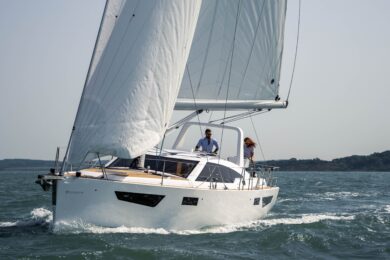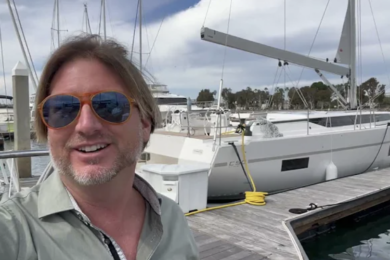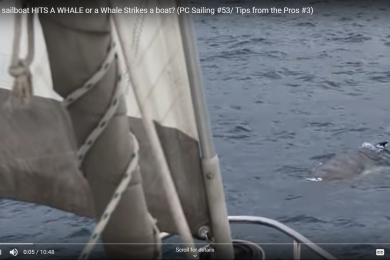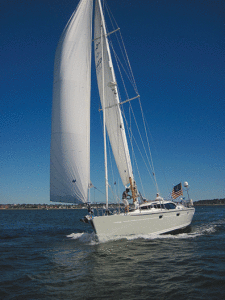 Oyster 54 • The Oyster 54 offers true blue water capabilities in a cruising boat that will make a great couple’s floating home.
Oyster 54 • The Oyster 54 offers true blue water capabilities in a cruising boat that will make a great couple’s floating home.
It was one of those perfect Indian Summer afternoons in Newport, R.I. when we set off from the mooring in Brenton Cove to give the Oyster 54 Tom Tom a whirl around Narragansett Bay. The sky was clear, the air warm and the breeze was blowing at a gentle 10 knots up the bay. And, despite it being a Thursday, there were dozens of boats out sailing as we all played hooky to get in one last sail before the snow flies.
We rolled out the in-mast furling mainsail and the 125 percent genoa and headed up wind and out of the bay toward open water. The 54 has electric halyard and sheet winches, so deploying the sails and trimming them was a cinch. Close hauled, we settled into the groove at about 45 degrees from the true wind and steadily increased speed until we were sailing at 6.5 knots in the 10 to 12 knots of breeze. We threw the boat through a series of tacks and found that she comfortably maintained a 90 degree tacking angle, which is normal for displacement, offshore cruising boats.
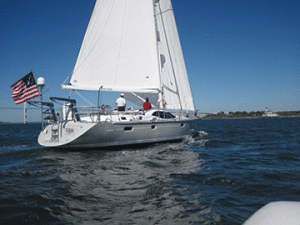 The breeze increased as we left the mouth of the bay and so did the feel of weather helm on the wheel. We eased the traveler, which runs across the deck just aft of the center cockpit, and that corrected the helm nicely.
The breeze increased as we left the mouth of the bay and so did the feel of weather helm on the wheel. We eased the traveler, which runs across the deck just aft of the center cockpit, and that corrected the helm nicely.
As we sailed back into the bay, we put the 54 on a broad reach and tried to power her up as much as possible until we were slipping through the water at close to eight knots. The helm felt very responsive for such a big boat and she tracked well as we rode through some stronger gusts of wind at the mouth of the bay.
Finally, we jibed the headsail over and set her up to run wing and wing up the bay for a while. This is how she would be rigged, with the addition of a spinnaker pole to wing-out the headsail, for trade wind passages, just the sort of sailing the Oyster 54 was designed for. Oysters have sailed all over the world and may be one of the most popular brands out there circumnavigating today. Like her sisterships, the 54 is a solid, moderate displacement center cockpit, deck-salon cruiser that will look after you through thick and thin.
THE DESIGN
Rob Humphries has been designing the new Oysters for quite a while now, and has gradually modernized both the look and the design parameters of the boats. The 54 has a sweet hull, with fairly short overhangs at the bow and stern and thus a fairly long waterline, at 46 feet three inches for a boat of this size. The long waterline means the boat will have a comfortable ride through the waves and will be able to maintain fairly high average speeds.
Under the water, the boat we sailed has the optional shoal bulb keel. We could not discern any tenderness as we heeled to the breeze and if we were making some leeway it was unnoticeable. The standard 54 comes with a deep bulb keel and a seven foot, 10 inch draft as opposed to Tom Tom’s five foot, 10 inch draft.
To keep up with a modern trend for truly shoal draft cruisers, Oyster has introduced a centerboard option for many of their designs that enable owners to really explore the thin waters of regions like the Bahamas, southern New England and the Chesapeake Bay. The centerboard version of the 54 has a board-up draft of only five feet, one inch and a deep board-down draft of a whopping 11 feet, seven inches.
The boat has a displacement of 46,893 pounds and has a displacement-to-length ratio of 211. This is considered moderately light by traditional standards, yet in today’s fleet of light weight cruisers a ratio of over 200 is something of a rarity. For those who will be making long passages or exploring the higher latitudes, this displacement will translate into a comfortable ride that will not wear down the crew.
The rig stands 70 feet above the water so the 54 is too tall for the Intracoastal Waterway of the U.S. East Coast. Yet this is not a terribly tall rig for a 54 footer and the sail-area to displacement ratio of 19.8 indicates that the boat has enough sail power to perform well but is not over rigged to the point that you will need to reef too early.
A sensible blue water design, the 54 favors the conservative side of the design compromise which should give her owners confidence to meet whatever the seas throw at them.
LIVING ABOARD
Raised cabin tops and large, space-age windows are so common today that it is hard to recall that Oyster truly made this concept popular 20 years ago. There have been steady design evolutions in the raised deck salon look over the years but the essential concept remains in place. And, Oyster’s trademark center cockpit deck layout is all part of the equation.
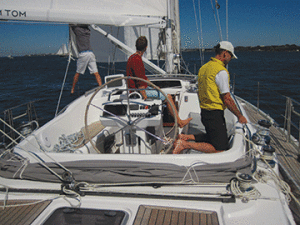 The cockpit is large and commodious and will be the center of life aboard during the day and when sailing. A large table with folding leaves runs down the middle in front of the single wheel and pedestal so you can seat six for a meal comfortably. When sailing at night, the cockpit seats are large enough for a standby watch- keeper to nap in comfort.
The cockpit is large and commodious and will be the center of life aboard during the day and when sailing. A large table with folding leaves runs down the middle in front of the single wheel and pedestal so you can seat six for a meal comfortably. When sailing at night, the cockpit seats are large enough for a standby watch- keeper to nap in comfort.
The 54 has been given a low profile look and the lines of the raised cabin flow easily into the cockpit coaming and forward into the flush foredeck. The side decks are wide and made secure by the small rolled bulwark that runs all around. The chainplates are inboard for proper sheeting angles and that means they are not in the way as you walk fore and aft. The foredeck is large enough to carry an inverted RIB when on passage. There are huge lockers in the forepeak and aft under the afterdeck where you can stow dock lines, fenders, downwind sails and all of the sundry cruising gear you need.
 Down below, the saloon offers a kind of sofa-in-the-round layout with the dinette to starboard and a large curved settee to port. The table folds out to reach the port settee so you could seat up to eight for dinner. The chart table is tucked away in the aft starboard corner of the saloon and the galley, with long counter tops and a huge amount of storage and fridge space, lies in the passageway that leads to the master stateroom aft.
Down below, the saloon offers a kind of sofa-in-the-round layout with the dinette to starboard and a large curved settee to port. The table folds out to reach the port settee so you could seat up to eight for dinner. The chart table is tucked away in the aft starboard corner of the saloon and the galley, with long counter tops and a huge amount of storage and fridge space, lies in the passageway that leads to the master stateroom aft.
If Oysters are about anything, they are about luxurious master staterooms aft. And the aft cabin in the 54 is no exception. The double berth is huge and built on the centerline with floor space on both sides; this simple feature makes getting into and out of the berth just like getting in and out of your own bed at home, and it vastly improves the convenience of making the bed.
The aft cabin has ample storage and hanging lockers, large drawers and a useful vanity-desk. The master head has a huge shower stall and plenty of locker space for toiletries, a medical kit and much more.
If the master cabin aft is amazing, the guest cabin forward is no cubby hole either. In fact, the forward cabin would be a fine master cabin on most boats. It has a walk around double berth, plenty of storage space and an en suite head that also has a large shower stall.
Just aft of the guest cabin, a small cabin has upper and lower berths for children or crew. This space would also make a fine floating office and communications center. Or, it could be a workshop.
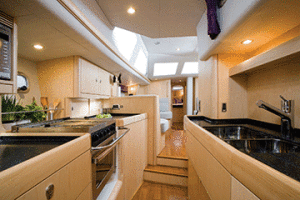 The finish work of Oysters is well known and admired. The boat we sailed had very light colored wood bulkheads and cabinetry that gave the interior a bright and airy feel. Increasingly, Oyster has become a superyacht company with models up to 125 feet. The style of the superyachts is based on impeccable yacht finish, the finest hardware, and choicest veneers and fittings.
The finish work of Oysters is well known and admired. The boat we sailed had very light colored wood bulkheads and cabinetry that gave the interior a bright and airy feel. Increasingly, Oyster has become a superyacht company with models up to 125 feet. The style of the superyachts is based on impeccable yacht finish, the finest hardware, and choicest veneers and fittings.
This superyacht style is trickling down to the smaller yachts in the fleet and adds a quality level that is hard to match. The fit and finish of the 54 looks more like a superyacht than your conventional upscale cruising boat.
THE NEW 545
The 54 we sailed was the last boat to be built in the 54 line. But that’s not exactly true. The boat is being replaced with an updated 545 that uses the same hull and rig but a redesigned deck with flush hatches instead of the raised hatches on the older design.
Down below the 545 will have several layout improvements including a new chart table, nav station that is better integrated into the saloon.
Expect the finish to be influenced even more by the superyacht styling of the larger boats and to have a wider range of options for creating an interior that reflects an owner’s personal needs and taste.
The new 545 will have all of the fine sailing and performance characteristics of the 54 and will be an excellent couple’s cruising boat that can take intrepid sailors anywhere the wind might blow them in safety, style and comfort.
Oyster 54 (545)
LOA 53’11”
LWL 46’3”
Beam 15’7”
Draft (std.) 7’10”
Draft (shoal) 5’10”
Draft (CB up) 5’1”
Draft (CB down) 11’7”
Displacement 46,893 lbs.
Engine(Diesel) 110 hp.
Fuel 224 gals.
Water 198 gals.
Sail area 1,658 sq. ft.
Mast height 70’6”
SA/D19.8D/L211
Oyster USA
Newport, R.I.
(Ph.) 401-846-7400(Fax) 401-846-7483
Newport@oysteryachts.com
www.oysteryachts.com

